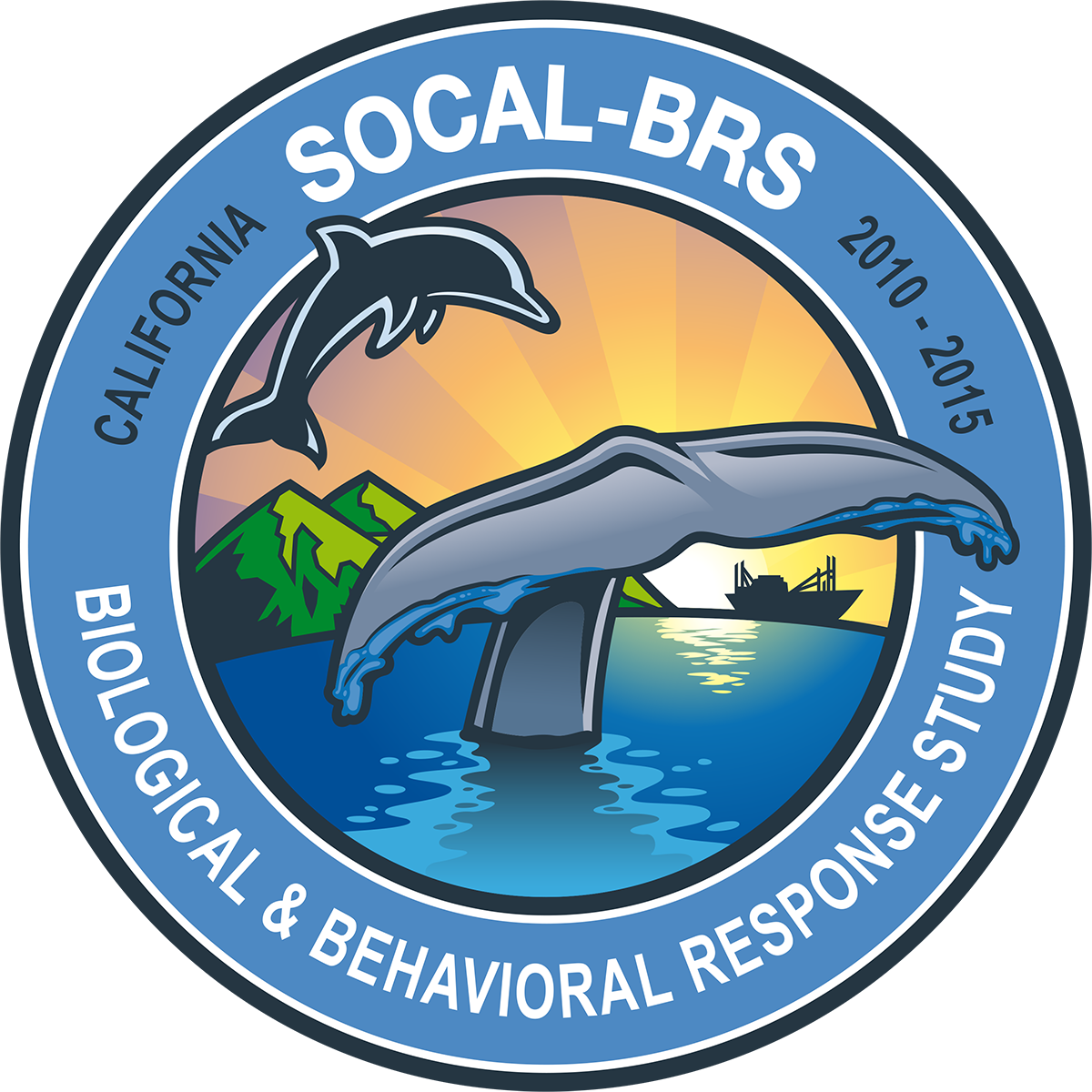SOCAL BRS
“SOCAL‐BRS” (Behavioral Response Study) is a multi‐year effort (2010‐2015) to designed to better understand marine mammal behavior and reactions to sound. It is an interdisciplinary research collaboration, building on previous efforts in the Bahamas and Mediterranean Sea. The overall objective is to provide a better scientific basis for estimating risk and minimizing effects of active sonar for the U.S. Navy and regulatory agencies. SOCAL‐BRS is also part of a larger international collaboration to measure the impacts of noise marine mammals using opportunistic and experimental approaches (including controlled exposure experiments, or “CEEs”). SOCAL‐11 extends existing collaborations among scientists from private sector and academic scientists, the U.S. National Oceanic and Atmospheric Administration (NOAA), and U.S. Navy researchers and operational personnel. It is jointly funded by the U. S. Navy, Chief of Naval Operations, Environmental Readiness Division (OPNAV N45) and the Office of Naval Research (ONR).

SOCAL-15
SOCAL-15 continues a multi-year research collaboration called the “SOCAL-BRS” (Southern California Behavioral Response Study). This project is designed to better understand the behavior of numerous protected marine mammal species that inhabit the southern California Bight and provide direct, controlled measurements of their reactions to sound, including military sonar systems. The overall objective is to provide a better scientific basis for estimating risk and minimizing effects of mid-frequency active sonar (MFAS) systems for the U.S. Navy and regulatory agencies. SOCAL-BRS includes collaborations among the National Oceanic and Atmospheric Administration (NOAA), private sector and academic scientists, and U.S. Navy researchers. It is jointly funded by the U.S. Navy Living Marine Resources Program (LMR) and the Office of Naval Research (ONR) and is part of an international collaboration to measure the impacts of noise on marine mammals.
Several successful field seasons of SOCAL-BRS have already been completed and over 170 tags have been deployed on individuals of nine different species and 83 complete experimental BRS sequences have been conducted on individuals from seven different federally protected marine mammal species (Cuvier’s beaked whale, Baird’s beaked whale, sperm whale, Risso’s dolphin, blue whale, fin whale, and humpback whale). The results of these experiments have been presented in scientific meetings and increasingly in the scientific literature.
SOCAL-15 will use similar configurations, protocols, focal species, equipment, and areas with an increasing reliance on smaller, adaptive vessel configurations. SOCAL-15 will build on earlier integrations of CEE methods with ongoing regular training operations to directly use Navy sonar systems in experimental applications. Whales will opportunistically be tagged around these activities at much greater distances than typically used in simulated sonar exposures. The experimental objective is to match received sound levels with those tested using simulated sonars but in a completely realistic scenario to study the relative effects on behavior of source type, received sound level, and physical range to sound sources.
SOCAL-14
SOCAL-14 continues a multi-year effort (2010-2015) called the “SOCAL-BRS” (Southern California Behavioral Response Study). This project is designed to better understand the behavior of numerous protected marine mammal species that inhabit the southern California Bight. It is also providing direct, controlled, high-resolution measurements of individual reactions to sound, including military sonar systems, to better estimate risk and minimize effects of mid-frequency sonar systems. Several successful field seasons of SOCAL-BRS have already been completed using an adaptive approach that optimizes the probability of good weather and finding and tagging different focal species.
Over 160 tags have been deployed on individuals of nine different species and 75 complete experimental BRS sequences have been conducted on individuals from seven different federally protected marine mammal species (Cuvier’s beaked whale, Baird’s beaked whale, sperm whale, Risso’s dolphin, blue whale, fin whale, and humpback whale). The results of these experiments have been presented in scientific meetings and in the scientific literature. A recent methodological paper summarizes the overall methods in detail: Using accelerometers to determine the calling behavior of tagged baleen whales.
SOCAL-14 will use similar configurations, protocols, focal species, equipment, and areas (based on lessons learned from previous field seasons) with an increasing reliance on smaller, adaptive vessel configurations in certain conditions. SOCAL-14 will also follow on the successful first integration of CEE methods with ongoing regular training operations to increasingly including realistic Navy sonar systems in experimental applications. SOCAL-BRS will continue to attempt to tag whales opportunistically around these activities at much greater distances than typically used in simulated sonar exposures to study the relative effects on behavior of source type, received sound level, and physical range to sound sources.
SOCAL-13
SOCAL-13 continues the multi-year effort (2010-2015) project “SOCAL-BRS” (Southern California Behavioral Response Study). This project is designed to better understand the behavior of a number of protected marine mammal species that inhabit the southern California Bight and provide direct, controlled measurements of their reactions to sound, including military sonar systems. The overall objective is to provide a better scientific basis for estimating risk and minimizing effects of sonar for the U.S. Navy and regulatory agencies. SOCAL-BRS includes collaborations among the National Oceanic and Atmospheric Administration (NOAA), private sector and academic scientists, and U.S. Navy researchers. It is jointly funded by the U. S. Navy Living Marine Resources Program (LMR) and the Office of Naval Research (ONR) and is part of an international collaboration to measure the impacts of noise on marine mammals. Three successful field seasons of SOCAL-BRS have been completed using an adaptive approach that optimizes the probability of good weather and finding and tagging different focal species. Over 120 tags have been deployed on individuals of nine different species and 55 complete experimental BRS sequences conducted on individuals from seven different federally protected marine mammal species (Cuvier’s beaked whale, Baird’s beaked whale, sperm whale, Risso’s dolphin, blue whale, fin whale, and humpback whale).
SOCAL-13 will use similar configurations, protocols, focal species, equipment, and areas, as previous field seasons with a few modifications. These include the testing and deployment of an even lighter sound source and smaller vessel configurations. Additionally, building on the experiences and planning in previous seasons and in coordination with ongoing Navy training operations, SOCAL-13 will for the first time include the use of realistic Navy sonar systems in experimental applications coordinated with already planned and regular training operations. SOCAL-BRS will attempt to tag whales opportunistically around these activities at much greater distances than used in our simulated sonar sound exposures to date. The experimental objective is to match received sound levels with those tested but in a completely realistic scenario. These experiments will mark the first such integration of realistic operations in behavioral response studies for mid-frequency military sonar and they are being closely coordinated and planned with the Navy and regulatory agencies.
SOCAL-12
SOCAL-12 is the third field season of a multi-year effort (2010-2015), more generally referred to as “SOCAL-BRS” (Behavioral Response Study). This interdisciplinary research collaboration of private sector, federal agency, and academic scientists is designed to increase knowledge of marine mammal behavior and changes in behavior as a function of sound exposure, including simulated military sonar, for various species. This project is funded by several research programs of the U.S. Navy and is integrated with related, ongoing field efforts along the U.S. west coast. It is also part of an international collaboration to measure impacts of human activities on marine mammals using a variety of opportunistic monitoring methods and experimental controlled exposure experiments (CEEs). The overall objective of these efforts is to understand and thereby better reduce potential negative effects of sounds, including military active sonar systems, on a broad range of marine mammal species.
SOCAL-12 follows two successful field campaigns and will have similar operational configuration, protocols, methodology, focal species, equipment, staff, and operational areas. Analyses of SOCAL-10 and -11 data are progressing on multiple fronts and the information obtained, operational lessons learned, and consequent expectations based on the two previous field seasons were considered in detail to refine and enhance subsequent field efforts. Resulting modifications of protocols and priorities for SOCAL-12 were developed in the course of these discussions and are presented here in the plans for the 2012 field season, which is spread over a much larger portion of the year. Species priorities will shift to a greater emphasis on offshore species such as beaked whales, Risso’s dolphins, and fin whales, when conditions are appropriate; a more targeted approach on blue whales in other specific conditions will augment the existing large dataset on this species.
Two primary phases in July/Aug and October will use the same primary research vessel with contrasting applications of towed passive acoustic capabilities. Several significant modifications include the use of an even lighter sound source enabling a pilot effort based off San Clemente Island using a small Navy service fast boat. Additionally, SOCAL-12 will be a transitional year in several ways. As SOCAL-BRS moves toward the use of real Navy sources in an experimental context in 2013, SOCAL-12 will strategically target operational areas most likely to be utilized in that regard, again within the context of adaptive selection of optimal field conditions.
SOCAL-11
SOCAL-11 is second field season of a multi-year effort (2010-2014), more generally referred to as “SOCAL-BRS” (Behavioral Response Study); for more information on our very successful first field season please see SOCAL-10. SOCAL-11 is an interdisciplinary study of basic behavior and responses to controlled sound exposures in a variety of marine mammal species, building on a number of related efforts. The overall objective is to provide a better scientific basis for estimating risk and minimizing effects of active sonar for the U.S. Navy and regulatory agencies. SOCAL-BRS is part of a larger international collaboration to measure the impacts of noise marine mammals using opportunistic and experimental approaches (including controlled exposure experiments, or “CEEs”).
Specific objectives for SOCAL-11 include:
- Obtaining baseline behavioral data on a range of marine mammal species
- Conducting CEEs on baleen whales, beaked whales, Risso’s dolphins, sperm whales
- Testing optimal configuration for subsequent studies, which may include realistic/actual military sources
- Obtaining data to support the Navy’s SOCAL range monitoring efforts
This project is very much an interdisciplinary collaboration of biologists, acousticians, engineers, and other scientists from a variety of academic, private, and government research organizations. Brief descriptions of the roles of these organizations in the overall SOCAL BRS effort are given here.
SOCAL-11 operational area includes both “inshore” areas along southern California from Morro Bay to San Diego and an offshore area that includes the U.S. Navy’s SCORE range near San Clemente Island. SOCAL-11 sound transmissions will occur more than 1nm from any land mass and 4 more than 3nm from any land mass within the Channel Islands National Marine Sanctuary (CINMS).
SOCAL-10
Marine mammals around the world, including along the U.S. west coast, face many challenges due to interactions with people, from overfishing and entanglement to vessel strikes and disturbance from human sounds. Most of these issues remain poorly known and carefully conducted science is needed to manage and protect marine animals.
SOCAL-10 is a research project integrated with ongoing studies of basic diving, foraging, social behavior, and sound production of marine mammals in important biological areas near southern California. It extends previous studies of whether and how animals change their behavior when they hear different sounds.
SOCAL-10 is an interdisciplinary collaboration of experts in marine mammal biology and behavior with extensive field experience in safely and ethically measuring responses to controlled sound exposures.
This project will take place during August and September 2010 in coastal areas from San Diego to Santa Barbara and the Channel Islands, as well as an offshore area on and around the U.S. Navy’s training range near San Clemente Island.

